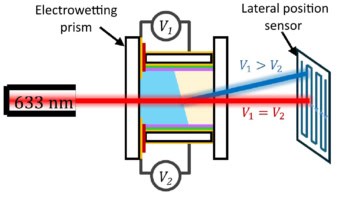
Spider silk has been used by researchers in Taiwan to create tuneable lenses capable of focusing the shapes of incoming laser beams. The work was done by a team led by Cheng-Yang Liu at National Yang-Ming University, who developed the lenses by treating freshly extracted silk with drips of resin, under tightly controlled conditions. Their approach could offer significant improvements to existing biomedical imaging techniques.
Spider silk is well known for its useful mechanical properties including high values of elasticity, toughness and tensile strength. Yet the material also has fascinating optical properties. In recent studies, for example, researchers have noted its potential for photonics applications such as light guiding, imaging and sensing.
In their study, Liu’s team focussed on creating photonic nanojets (PNJs) using spider silk draglines – the strong spokes that form the basic structures of many spiderwebs. Typically, nanojets are formed when a transparent microscopic lens is illuminated on one side, creating an intense, focused point of light on the shadowed side through the effects of scattering, refraction, and diffraction.
Dripping resin
To create the lenses, the researchers first reeled stretches of dragline silk directly from long-legged cellar spiders. They carefully controlled the temperature, humidity, and reeling speed to ensure the fibres were smooth and uniform. They then dripped a resin onto the raw surface of the silk. Due to the wetting properties of the material, this caused it to distort into domes, whose shapes varied depending on how long they were left under the drip. Once the desired shapes were reached, the silk was placed in an ultraviolet oven for the resin to cure.

Changing humidity gets spider silk in a twist
To produce PNJs from these lenses, Liu’s team first explored their optical properties through numerical simulations. These calculations revealed how the focal lengths, focusing sharpnesses, and peak focusing intensities of the beams each depended on the lens shapes. The calculations also showed that these properties could be finely tuned by controlling the time the domes spent under the resin drip. Through experiments, the researchers then showed that when visible laser beams were fired at their lenses, sharp PNJs could be focused far away from their flat, shadowed sides.
The mechanical properties of spider silk offer many advantages over the synthetic fibres currently used in tissue engineering. For example, the material is biocompatible and can be easily absorbed by the body. Because of this, Liu’s team believe the PNJs made possible with their lenses may lead to safe and reliable new ways to image biological tissues. If achieved, this could enable researchers to create large-area, high-resolution images of samples, and to scan tissues to a range of different depths.
The research is described in the Journal of Applied Physics.



